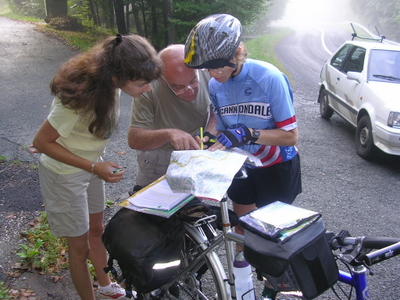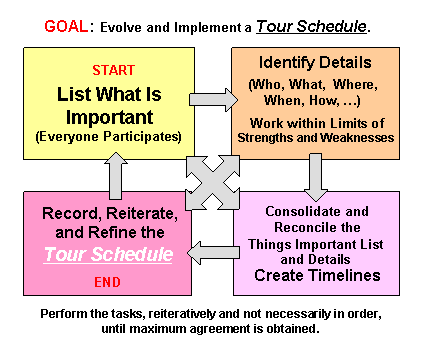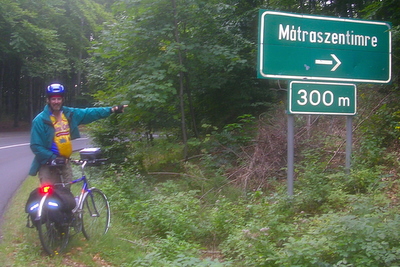
All About Tour Planning, v11
A How-To Guide for the
Travel Planning Process
Tour Planning and Terms Overview
Planning Overview:
Goal: Evolve and implement a Plan (here, a Tour, Schedule, or Itinerary) that achieves maximum agreement within the bounds of known practical capabilities.
Planning Terms:
- Strategy means to "determine what is important" (derived from the ancient Greek word: Strata, meaning "layer") - layer the concerns, order the layers. Note that what is most important changes over time.
- Plan means to "schedule actions ahead of time" (Latin roots, thought to have derived from planare, "Plant" or "To Plant") - one of early man's first formal communal strategies was to decide who would do what and when for the upcoming planting season. A plan has Purpose.
- Purpose means to attain a "desired effect" for known or perceived situation. The desired effect is usually identifiable (and there can be undesired effects).
- Decide means to "select one choice over another" (derived from Latin, decidere, to cut off - "cide" as in Homicide or Insecticide, literally "kill what is at one side for the other"). A decision consists of two parts; the Process and the Result. If you are a lawyer its all about the Process, for most other people its about the Result.
- Tactic means to
"implement situational
actions"
(derived from Greek, taktikos,
to order or form, from taktos, to arrange)
- order or arrange actions. The actions
may have been:
- Predetermined, based on a plan
- Selected from pre planned options (alternative scenarios)
- Created on the spot (ad hoc, situation determined).
- Scope means to "determine the bounds of operation" (derived from Greek skopos, to watch or look at) - Look at how to attain What is Important (from Strategy) within the practical bounds of capabilities (a.k.a., Strengths and Weaknesses) given the planning purpose.
- Risk means
"dangerous chance"
(derived from Latin risco, riscio, run into danger) -
Composed of two components, both an undesired
event-action-consequence-cost and the probability of such.
At key points, good planning sessions ask "What can go
wrong" and at some point those issues are addressed.
There are risks for which nothing can be done and there
are risks where mere knowledge about them makes them
become unlikely [which is the reason behind our presenting
our tips and lessons learned as well as our travel logs].
Related Concepts (at page bottom).
Planning Tasks
Of the two following sections, the next section identifies the main tasks for any kind of plan and then details the specific tasks to generate a Touring Plan, Schedule, or Itinerary. Then the subsequent section displays a high level Tour Planning process in the form of a process graph.
Planning Process Task Details:
Perform the following tasks reiteratively and not necessarily in order, until everyone is happy (or maximum agreement is obtained). The main tasks, identified in Blue colored text (Not Dark-Blue text), will work for any kind of plan. Note that all task details relate to and/or effect other task details, thus cycles of refining iterations are beneficial to detail integration as well as detail change integration.
Generally there are four major planning tasks (or parts):
- Make a List of What is Important, Individually.
- Evolve and Identify the "Things Important" Details and Planning Scope.
- Reconcile & Group the Individual Things Important Lists and Details.
- Record, Reiterate, and Refine the Plan (until maximum agreement is attained within the operating boundaries, understanding that extenuating factors may cause plan changes).
- Make a List of What is Important, initially by person - On the first iteration, capture all items/ideas and No pooping. At this strategy planning level, this activity is to First "Identify What is Important," and Later "Rank (or Layer) What is Important." Rank What is Important individually before conducting any group ranking or re-evaluation. Ranking may be refined or revised in subsequent iterations. For example, in a later iteration, indicate with a plus or minus sign, a couple of the most important items as well as a few lesser important items.
- Some 'Things of Importance' are known up front
(the really satisfying one's come from childhood).
Some Things of Importance are learned or remembered
from reviewing
travel books, maps, encyclopedias, recommendations,
(online) research, friends, and/or recent travelers.
The Term 'Things Important' was first coined by John Zachman, a friend. - Things of Importance relate to Goals and Purpose, which may be known, implied, unspecified, unknown, or understood without being stated. Sometimes Goals and Purpose are not known, identifiable, or learned until the Things Important list is materialized. One can help evolve or refine the other.
- Some Things of Importance are more important than others and this relates to Goals and Purpose (individual and group). It helps to understand these dynamics and issues for resolving later schedule conflicts. Priorities and importance change over time and they change as other items of importance evolve.
- Evolve and Identify the
"Things Important" Details and Planning Scope.
Gather facts, if needed or as needed, for
decision making and recognize or identify
the operating boundaries, limits, and resources.
- Identify the related Who, What, Where, When, Why, and How's.
- Identify and work within the bounds of your Strengths and Weaknesses - That is, know the constraints, rules, boundaries, and limits of time, money, resources, endurance, priorities, distance, transportation, environment, companion(s), and capabilities.
- Identify and follow up where more information may be needed.
- Reconcile the Individual Things Important Lists and Details. Initially the separate Things Important Lists are merged, ordered, and organized into one master list. Decisions about what to keep in the plan and what to let go are initiated here. Timelines are to be generated, loosely at first but refined over time, adapted, and reconciled for any later changes. The reasons for the order of things should be formally or informally known.
- Evolve a consolidated Things Important list (achieve maximum agreement with minimum discord).
- Evolve a Things Important touring date range and create timelines, loose at first.
- Track the reasons "why" some key events need to be in a certain order or fall on a certain day. Generally, tracking can be informal but there are usually some key issues worth formal notation. Also note any known opportunities or curiosities of interest, like taste local meal X or observe X thing in X village/provence/region.
- Record, Reiterate, and Refine the Schedule (also known as the Itinerary, Plan, [or Orders/Order - military/tacktic]). The Schedule is finalized here after one or more iterations. Decisions are finalized about what to do, bring, rent, make, or buy. When all is finalized and there is a group consensus (or maximum agreement), then the plan is set up for execution at a pre-designated time, this includes conducting any pre plan tasks (like reservations and purchases). Alternate scenario ideas need to be tracked in case later information or priorities change in the planned schedule. The inability to achieve/perform/conduct a pre plan task may necessitate implementing alternate plans or additional planning iterations for plan attainment and/or schedule refinement. Ultimately a physical schedule is to be created and shared. Some of the following points will help make a more survivable schedule.
- Decide/List event order and reconcile timelines:
- Some events become main path sequences. Some events become subordinate to a main event occurring or completing first. Some events can't be done or will conflict - Decisions need to be made.
- Conduct any Do, Bring, Rent, Make, or Buy Decisions: For example, discuss and decide (based on fit and everyone's level of confidence, experience, comfort, strengths, and weaknesses) whether to create and manage your own tour or to buy into an existing mega-tour or multiple mini-tours, or to mix tour types. This concept applies to many other touring decision issues.
- Be flexible and facilitate flexibility into the Schedule:
- Be open to changes and opportunities discovered while conducting further planning. Be open to time/event shifting.
- It is wise to address scenarios before hand, to address possibly known or unknown things that may effect the plan or its implementation:
- Sometimes external factors drive decisions, like destination holidays, seasons, days of the week, and things politik.
- Sometimes trips of long travel distances or trips with many connections need built in empty time periods to compensate for possible enroute delays, especially for the first day of arrival. Sometimes, some open time allows for "on site decisions," "on the fly changes," or "down time."
- Some month or months long trips need allowances for sick days, delays, and maintenance (human and mechanical) - About one free day for every two weeks or so.
- Address Risks:
-
No one avoids all risks and some risks must be taken.
Some risks can be avoided or better mitigated
with knowledge and experience (which is
why this travel knowledge
sharing web site exists).
- Travel Planning Details Checklist
- Bicycle Tips, Hints, and Lessons Learned (also with touring checklists)
- Travel Tips, Hints, and Lessons Learned
- Buying Insurance
- Assigning more schedule time
- Making and pre paying reservations
- Letting some other agency handle all, or some, of the details
- Prioitizing a list such the lesser important items may be last or skipped
- Creating alternate plans
Tour Planning Proccess Graphic (High Level Overview):

Plan Execution
NO travel plan in the world has ever been perfectly executed! Something always happens to cause situational changes (aka tactical changes to the plan). Expect it, be of good spirit, and embrace the positive aspects of an exposure to new opportunities.
The first casualty of a campaign is the plan. - American General
Yes, Aeschylus said it was Truth, and a Poet said it was Innocence. They're all right, but we digress ...
Situational Choice and Control Issues [eventually, one wants both]:
If a traveler does not have the time to plan a tour, or it is too late into the season, or this kind of foreign travel is too much to handle (initially) then joining an established tour group has many advantages.
We evolved to making our own reservations to best represent our own interests and to be able to have "choice" and "control" during the tour. We progressed from booking tours, to using a travel agent, to setting everything up ourselves. Its a very natural course to follow. If a person uses a travel agent, one cannot make any changes without going through the agent - all good site destinations work with that ethic, even if a traveler is at the tour site and the travel agent is twelve time zone hours away and/or closed, the traveler still must go through the agent. If the agent is lazy, inefficient, or otherwise constrained (tight office budget) and has not followed up, the traveler (you) can't initiate, confirm, or change anything, one must go through the agent. If a person does their own bookings then the tour-ist can adjust to on the spot changing of external requirements or conditions.

Additional/Related Planning Terms and Definitions
Risk Management is a process that ranks and mitigates the known risks. Ranking can be informal (instinct or intuition) and/or formal (Comparatively Ordered: Risk = Cost x Probability]). There are risks for which nothing can be done, such that the chance must be taken or the planned action abandoned. Mitigation can be, both, the action/plan taken to address the risk if it occurs and Mitigation can mean the entire process of identifying the risk and performing preventive measures before hand to stop the risk, reduce the risk probability, or reduce the risk's undesired outcome. Costs, while usually monetary, can also be measured in terms of life, time, opportunity lost (aka opportunity cost), good will, reputation, resource (loss, miss-allocation, allocation choice cost), control, position, timing, effort, and degrees of security or safety confidence. Strategic Planning is about changing the known practical capabilities (to meet a presently unattainable goal in the future). Objective and Goal: The Terms are not known to exist in the Roman-Latin or Greek time periods. The terms evolved, apparently, during the mid to late 'Middle Ages.' The terms are interchangeable. When presented in documentation (for business, government, academic, ... ) the terms are typically assigned a more specific meaning. Frequently, in U.S. business and military circles, Goal is generally used for describing a desired Strategic Result and Objective is generally used for describing a desired Tactical Result.
- "Goal" (derived from Middle English, originally boundary, limit, perhaps to hinder or impede) - Its usage has evolved from a boundary limit to a desired destination, state, end point, or aim. Currently, a Goal is the desired result to which effort is directed.
- "Objective" (derived from Middle English using Latin roots, ob, to, toward, against; jec, to throw, jet, eject; - Objective has evolved to mean a result toward which effort or action is intended to attain.